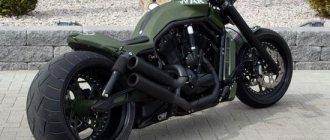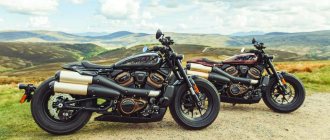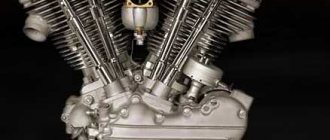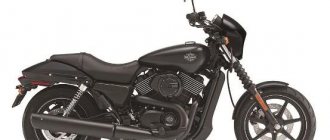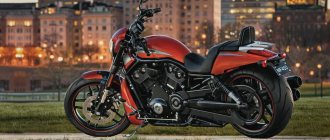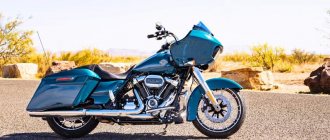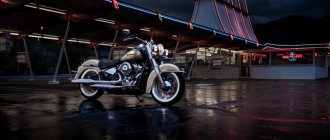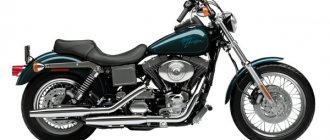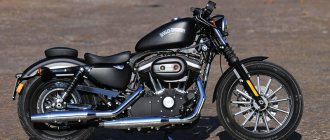- motorcycle model, BMW brand
BMW Motorrad, the motorcycle division of the Bavarian auto giant, has unveiled the new R 1250 GS bike. It should be the successor to the popular R 1200 GS. The bike received a number of innovations, including a more powerful and larger engine.
The BMW R 1200 GS was first introduced in 2004, and since then it has consistently occupied a leading position in the company's sales volumes around the world. The bike has maintained continuity over many generations, with the biggest design update being the addition of a liquid cooling system in 2013. Now it's time for new major updates to make the motorcycle more powerful, more modern and safer.
Design of the BMW R 1250 GS
The design of the BMW R 1250 GS is very similar to its predecessor, as it does not introduce significant changes. The motorcycle lighting was modernized and became LED. In addition to the main light and turn signals, the motorcycle can optionally be equipped with LED DRLs.
Not without updated on-board electronics, which are controlled by a 6.5-inch LCD screen as a dashboard. It is also used in navigator mode, used for telephony and multimedia functions. You can connect to the on-board system via Bluetooth.
The front suspension of the BMW R 1250 GS is based on the already classic German Telelever fork with 37 mm feathers, which provides good handling and prevents “dive”. The rear swingarm is represented by a cast monotube fork made of aluminum alloy. However, there were some changes. The load compensation system is now fully automatic, whereas previously there was a semi-active electronic suspension. The front suspension travel is 190 mm, the rear – 200 mm.
BMW R 1250 GS wheels are cast, made of aluminum alloy. 120/70 R19 tires are used at the front, and a wider 170/60 R17 tire is installed at the rear. It should provide high-quality grip on the road for a good start without slipping.
For braking, the new bike uses twin discs at the front, 305 mm in diameter, with floating 4-piston calipers. At the rear there is a single disc with a diameter of 276 mm, also with a floating caliper, but with 2 pistons.
The dimensions of the new motorcycle can be called familiar for this class of equipment. The length of the bike is 2207 mm, the wheelbase is 1525 mm, and the width is up to 952 mm. The seat height without load is 870 mm. Naturally, the BMW R 1250 GS turned out to be quite heavy, its curb weight reaches 249 kg, and its payload capacity is up to 216 kg.
The fuel tank holds 20 liters of fuel. Gasoline consumption on the highway is 4.75 liters per 100 km, so the capacious tank allows you to make long trips without refueling.
Bavarian flagship tourenduro
BMW motorcycles are well known among bikers, but for an ordinary person who does not understand motorcycle technology, it often comes as a surprise when he hears that the BMW company produces not only cars, but also motorcycles. Meanwhile, these “iron horses” were produced even before the start of World War II, so Bavarian manufacturers know a lot about two-wheeled vehicles.
Moreover, the hero of today’s review, the large touring bike BMW R 1250 GS, is not just “some kind of BMW Motorrad”, but a standard among heavy touring bikes.
Brief legend
BMW GS series motorcycles debuted at the very beginning of the 1980s. The first "Goose", or as it was then called, the BMW R80G/S, became the world's first production touring enduro.
Over the past decades, bikes in this series have been modernized several times, but the same “Goose”, whose successor was the BMW R 1250 GS, debuted in 2004 (as the BMW R 1200 GS). The last global update of which was carried out in 2013 - then its engine received liquid cooling.
The BMW R 1250 GS, which debuted in 2021 and was significantly upgraded in 2021, does not look much different from its predecessor. Its main difference was, once again, an updated engine, correspondingly increased to 1250 cubic meters of volume and already developing a power of 136 hp. with a torque of 142 Nm... plus a huge number of various electronic assistants that help the pilot when driving on roads of varying quality.
Skeleton and plumage of the "Goose"
Externally, the 2021'BMW R 1250 GS is still the same classic "Goose", if you do not know that this is an updated model, it is difficult to distinguish the 1200 cc model from the new model (only admirers will recognize the new motorcycle by the updated optics, which, in the spirit of time, became LED).
It’s difficult to call the new “Goose” beautiful, like the old one - the design is specific, but it has been verified by almost two decades of operation (if we take 2004 as the starting point).
The frame here is tubular steel, supporting the engine. At the same time, seemingly unnoticeable design improvements have turned the once clumsy “Goose” into a fairly modern bike... although the two boxer seats slightly spoil the impression - they stand out from the design.
But the boxer seats protect the rider’s legs during falls (of course, not as much as the arches of the Enduro package or the Adventure version, but it’s better this way than nothing) ... and less dirt flies onto the legs.
By the way, the design of the BMW R 1250 GS in the Adventure version is adjusted so that the pilot is almost not bothered by gusts of wind, rain and other such troubles. And the “Goose” seat is one of the best in its class, optional even for passengers.
Engine and gearbox
The engine, traditionally for large-volume BMW motorcycles, here is opposed (as in the old Soviet-made Urals and Dnieper, which, by the way, were copied from BMW even before the war).
Despite its “ancient design”, this engine was refined many times, its volume and power grew, and in the BMW R 1250 GS it has a power of 136 hp, “locomotive” traction at low and medium speeds, and even tries Don't get lost at higher than average speeds.
The engine received a VVT system - these are adjustable valve timing. The timing drive is now with toothed chains. And the drive to the wheel, as before, is cardan (only the cardan itself is lightweight).
The gearbox remained the old one - a six-speed, there were no special complaints about it on the old Geese, so it was decided to leave the gearbox on the updated model.
Motorcycle suspension
The front suspension of the motorcycle is Telelever, at the rear there is a pendulum with an automatic load compensation system.
In motion, it all works perfectly - when needed, it becomes softer or harder. There are no questions about the suspension of the new motorcycle yet, but given the reviews about the suspensions of the old 1200 cc model, the suspension must be reliable... otherwise, in the event of a breakdown, the cost of spare parts can be shocking.
Spare parts for the big “Goose” have always been expensive - you have to pay to own a legend, especially since the motorcycle rarely breaks down.
The “base” wheels are spoked - optimal for dirt roads, but cast wheels (made of aluminum alloy) are optionally available - with them you are more confident on the highway. The brakes are excellent, like all BMW motorcycles.
Equipment
In fact, this motorcycle is one of the most computerized in its class. When fully equipped, the only thing it lacks is adaptive cruise control, and even then only because of the specifics of a two-wheeled vehicle.
The dashboard is more like a tablet where all the necessary information is displayed, including navigation.
Main technical characteristics
The 2021'BMW R1250 GS continues the tradition of the "Gese" family - it is still the same reliable touring bike, only it has become more powerful, smarter and more comfortable (for the rider and for the passenger)... and even more expensive - in 2021 it is offered at a price from ≈ 2 million rubles.
Tags
1200 cc tourenduro motorcycles
Engine and transmission BMW R 1250 GS
The new BMW R 1250 GS is equipped with an enlarged engine with a displacement of 1254 cm³, which replaces the old 1170 cc power plant. The engine produces 136 hp. power on the shaft, spinning up to 7250 rpm, and develops a torque of 143 Nm, at a shaft speed of 6250 rpm. This is 11 hp. and 18 Nm more than the previous model provided.
The engine itself does not have any fundamental changes in the layout; it is still the same two-cylinder, 4-stroke, opposed-type internal combustion engine. This design of motor engines has remained the main one for the German manufacturer for over a century. The motor has short-stroke pistons with a diameter of 102.5 mm and a stroke of 76 mm. The compression ratio of the combustion chamber is 12.5:1, so the bike requires high-octane fuel (minimum AI-95, but preferably AI-98).
The manual transmission, which has 6 steps, as before, has not undergone major changes. The transmission uses helical gears and the clutch is wet and hydraulically driven. Power is transmitted to the wheel via a shaft, which is a classic BMW design.
Despite the external preservation of the general continuity of designs, the engine not only became more spacious, but also received a new timing system. The BMW R 1250 GS engine has a VVT (variable valve timing) system called. BMW emphasizes that the new bike is the first motorcycle in its lineup to receive a VVT system.
According to BMW engineers, the addition of variable valve timing has contributed to the increased performance of the R 1250 GS engine. The effect is achieved due to more complete combustion of fuel, improved exhaust and increased energy efficiency of the internal combustion engine. Thanks to the use of a three-way catalytic converter, the BMW R 1250 GS complies with Euro 4 emission standards.
Other changes to the power plant include a new drive of the camshafts, which is now carried out by a toothed chain. Consisting of many cells that evenly distribute the load, such a chain is much more reliable than the previously used roller chain. In addition to camshafts, the engine design also has a balance shaft, which reduces vibration and dynamic loads on the bike.
The engine also received a modified oil supply system that improves lubrication. The timing system uses a redesigned valve configuration, and fuel injection is now handled by two injectors per cylinder. The engine also received an improved exhaust system.
New BMW R 1250 GS and R 1250 RT
BMW Motorrad presents the new BMW R 1250 GS and R 1250 RT with an improved boxer engine.
Natalia Umnova
Thanks to the significantly improved boxer engine, the new BMW R 1250 GS and R 1250 RT achieve completely new levels of power and torque, smoothness and balance, especially at low engine speeds. Moreover, the new engine provides lower fuel consumption, produces fewer harmful emissions, and also has a particularly pleasant operating sound. For the first time in series production, BMW Motorrad engines feature BMW ShiftCam technology, which allows the lift and opening duration of the intake valves to be adjusted. In addition, the camshafts open the intake valves asynchronously, which leads to increased air swirl at the intake and guarantees better mixture formation and combustion.
Other technical changes to the engine include camshaft drive by a toothed chain (previously a roller chain), optimized oil supply, two injectors per cylinder and a new exhaust system.
Two riding modes are available as standard to tailor the motorcycle to the rider's individual preferences. The ASC system provides a high level of safety thanks to maximum traction in all conditions. The standard equipment of the BMW R 1250 GS and R 1250 RT also includes Hill Start Control. Driving Modes Pro with an additional Dynamic driving mode and traction control are available as an option. The BMW R 1250 GS also features Dynamic Pro, Enduro and Enduro Pro driving modes. The traction control system allows you to accelerate even more efficiently and safely, even when cornering.
The anti-lock braking system ABS Pro (part of the Pro driving modes option on the R 1250 GS and already available as standard on the R 1250 RT) provides even greater safety when braking, including when cornering. The new DBC Brake Assistant improves safety when braking, especially in emergency situations, by eliminating unintentional increases in engine speed. By intervening in engine management, it reduces torque during braking to take full advantage of the braking performance of the rear wheel. This keeps the motorcycle stable and reduces braking distance.
The optional BMW Motorrad Dynamic ESA Next Generation suspension automatically adjusts damping depending on the driving situation and driver inputs, and allows the motorcycle to maintain optimal geometry while compensating for additional load. The system allows you to achieve an optimal balance between comfort and controllability of the motorcycle. It is now also available for the BMW R 1250 RT.
The new R 1250 GS now features an LED headlight. LED daytime running lights are available as an option for both the R 1250 GS and R 1250 RT (halogen lamps as standard).
The new R 1250 GS is now equipped with the Connectivity multimedia system including a 6.5-inch TFT color display as standard. The driver can now quickly and conveniently access the functions of the multimedia system using the familiar BMW Motorrad Multi-Controller.
The R 1250 RT is equipped with a 5.7-inch TFT color display and an analogue speedometer and tachometer.
The optional Intelligent Emergency Call feature ensures prompt calling of emergency services in the event of an accident or other unforeseen situation that puts the life and health of the motorcycle driver at risk. As before, this feature is available for both models.
The editors recommend:
How to reduce washer fluid consumption?
Russians will be able to catch traffic violators on their phones
Where is it better to store a car - in a garage or outside? Opinions for and against
Advanced truck driver and savings on service: what do cargo carriers rely on?
New law: fine drivers for speeding 5 km/h
Discussion Cancel
I want to receive the most interesting articles
Peculiarities
The basic equipment of the bike includes an automatic stabilization control (ASC) system, as well as a hill launch control system. It allows you to automatically use the brakes when parking, releasing them when the bike moves forward. There is an automatic traction control function ASC for better handling. The basic driving modes include road modes, as well as a special rain mode for driving on wet roads.
Additional options include an improved dynamic traction control system, additional corner ABS, an advanced hill start control system, dynamic brake control, and support for a special Pro mode. Customization of external elements of the motorcycle, such as a muffler and body kits, is available.

